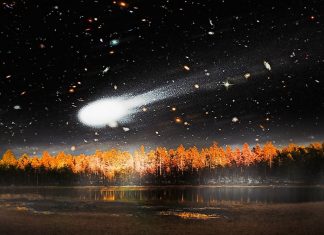Despite the fact that they can pose a serious danger to ships, icebergs are beautiful and amazing. As there are no two identical snowflakes in the world, so there are no two identical icebergs in it — they are all unique, and sometimes nature creates so bizarre shapes that we can only marvel at this beauty. However, only a few people have a chance to admire it by their own eyes, as icebergs drift far away from populated shores mostly.
Amazing facts about icebergs
1.About 90% of the total volume of the iceberg is under water always.
2.The density of the iceberg is about 10% lower than the density of sea water, so it stays on the surface until it melts.
3.The word “iceberg” means “ice mountain” in German language.
4.Some large and old icebergs are used as locations to drifting research stations where brave scientists work.
5.Icebergs are formed as a result of the breakaway of a large block of ice from ice shelves in the Arctic and Antarctica.
6.These floating ice mountains can travel great distances. Icebergs from the Arctic swim almost to Bermuda, located at a distance of 2500 miles (about 4000 km) from the place of their formation, for example.
7.There are projects nowadays, involving the use of icebergs to supply clean water to the arid regions of the planet.
8.Icebergs can drift in theocean for decades.
9.An international ice patrol was founded after the tragedy of the “Titanic”. It monitors the movement of icebergs and warns ships of possible danger. The service is funded by 17 countries.
10. Some of the icebergs are of enormous size. For example, in 2000, a giant ice mountain of more than 3800 sq. miles (~10,000 square kilometers) broke away from the Ross glacier in Antarctica.
11. Sometimes Antarctic icebergs can be seen in the area of the Brazilian city of Rio de Janeiro, at a distance of more than 3100 miles (about 5,000 kilometers) from the coast of Antarctica.
12. Since the beginning of the ice patrol in the North Atlantic not one person died by a collision with an iceberg.
13. Icebergs are mostly either white or bluish, or pale pink sometimes, especially in the southern ocean.
14. The height of icebergs reaches 100-115 feet (30-35 meters) sometimes.
15. As icebergs can damage oil platforms, some oil companies monitor and tow them. Sometimes blocks of ice weighing up to 3-4 million tons are moved.
16. About 100 000 icebergs constantly float In the coastal waters of Antarctica.
17. The content of fresh water all simultaneously existing in the world Ocean icebergs exceed all rivers and lakes combined (interesting facts about rivers).
18. On November 12, 1956, the American merchant ship found an iceberg of record size in the South Pacific. It had 208 miles (335 kilometers) long and 60 miles (97 kilometers) wide. This is larger than the size of the whole of Belgium.
19. The table-shaped iceberg differs from the pyramidal one by its flat and relatively flat top. Such icebergs are easily mistaken for Islands, especially in high latitudes, and this has happened more than once.
20. The white color of the iceberg indicates its young age. As it ages, it turns blue or green, as the air in it is partially replaced by water droplets.
21. One canadian company produces drinking water from melted pieces of icebergs that are caught off the coast of Newfoundland.
22. For safety reasons, icebergs are marked with bright colors, special services monitor them from space satellites and drop beacons from aircraft to them to track their movement.
23. Even the old iceberg, which has been drifting in the sea for years, can melt very quickly if its current carries it to warmer latitudes.
24. Russian scientist Lomonosov correctly explained the nature of the icebergs in the XVIII century.
25. The Northern icebergs are much more dangerous than the southern ones, as they have a habit of going down to the latitudes, where the main transoceanic routes lie.








































